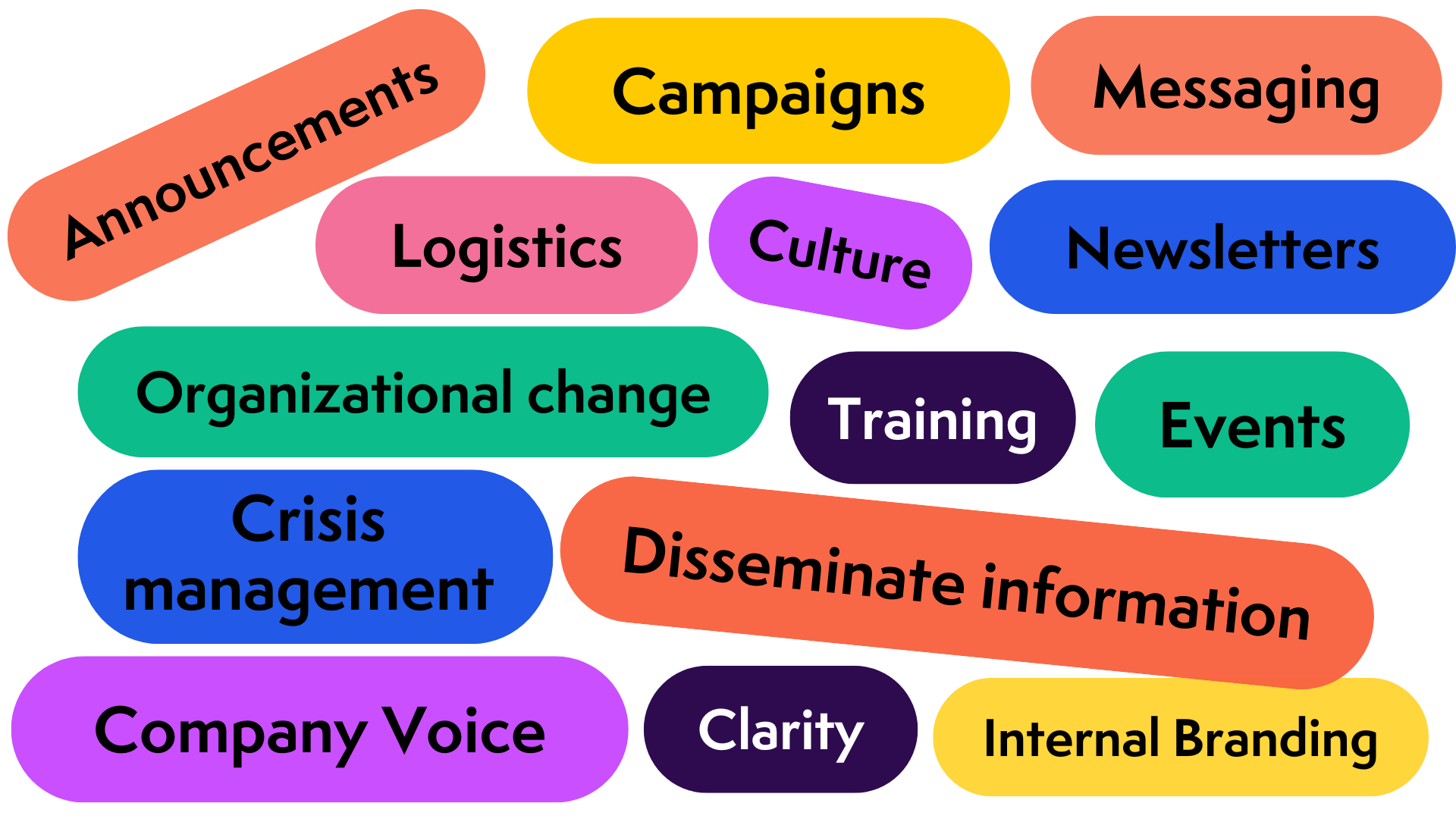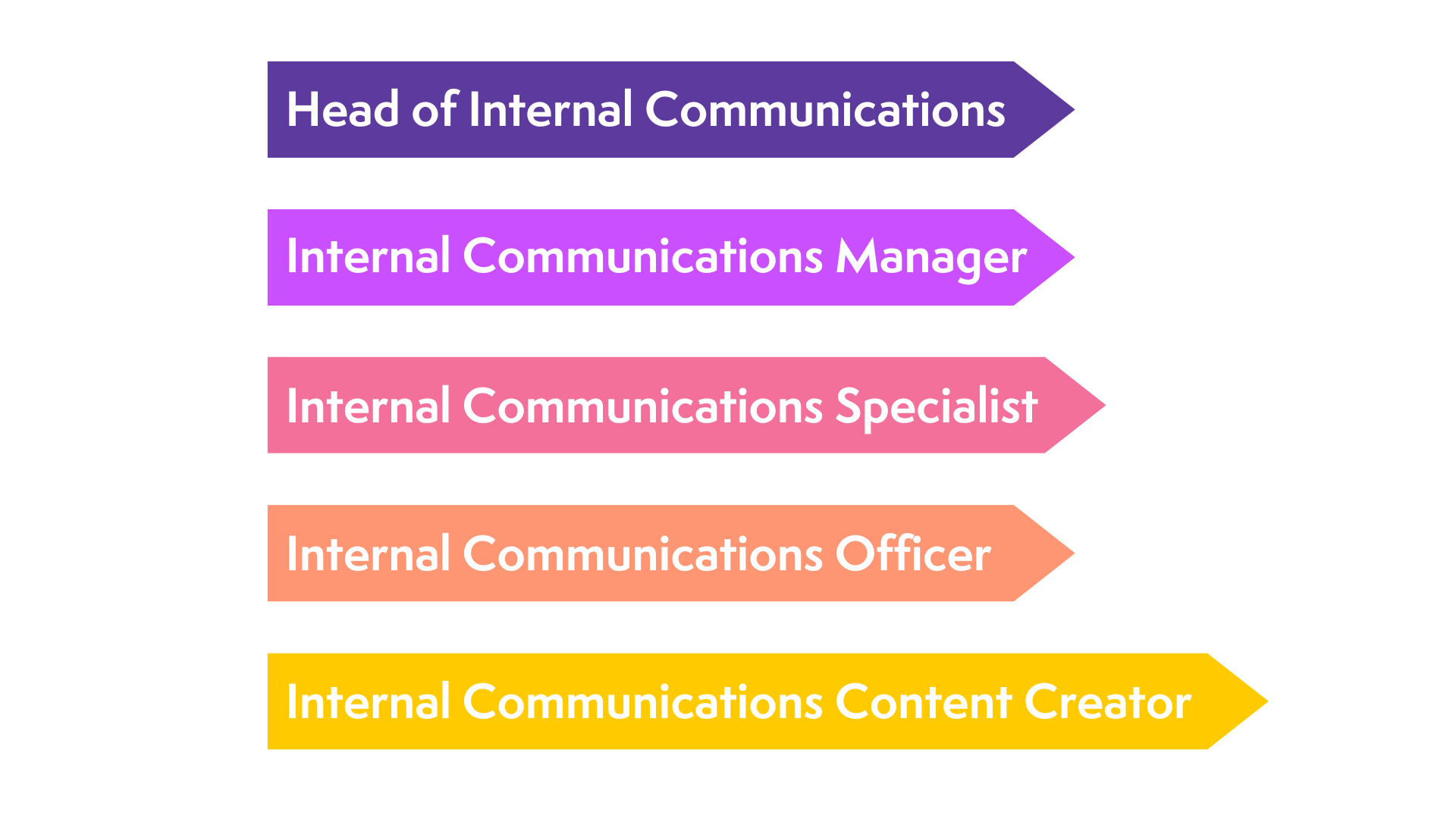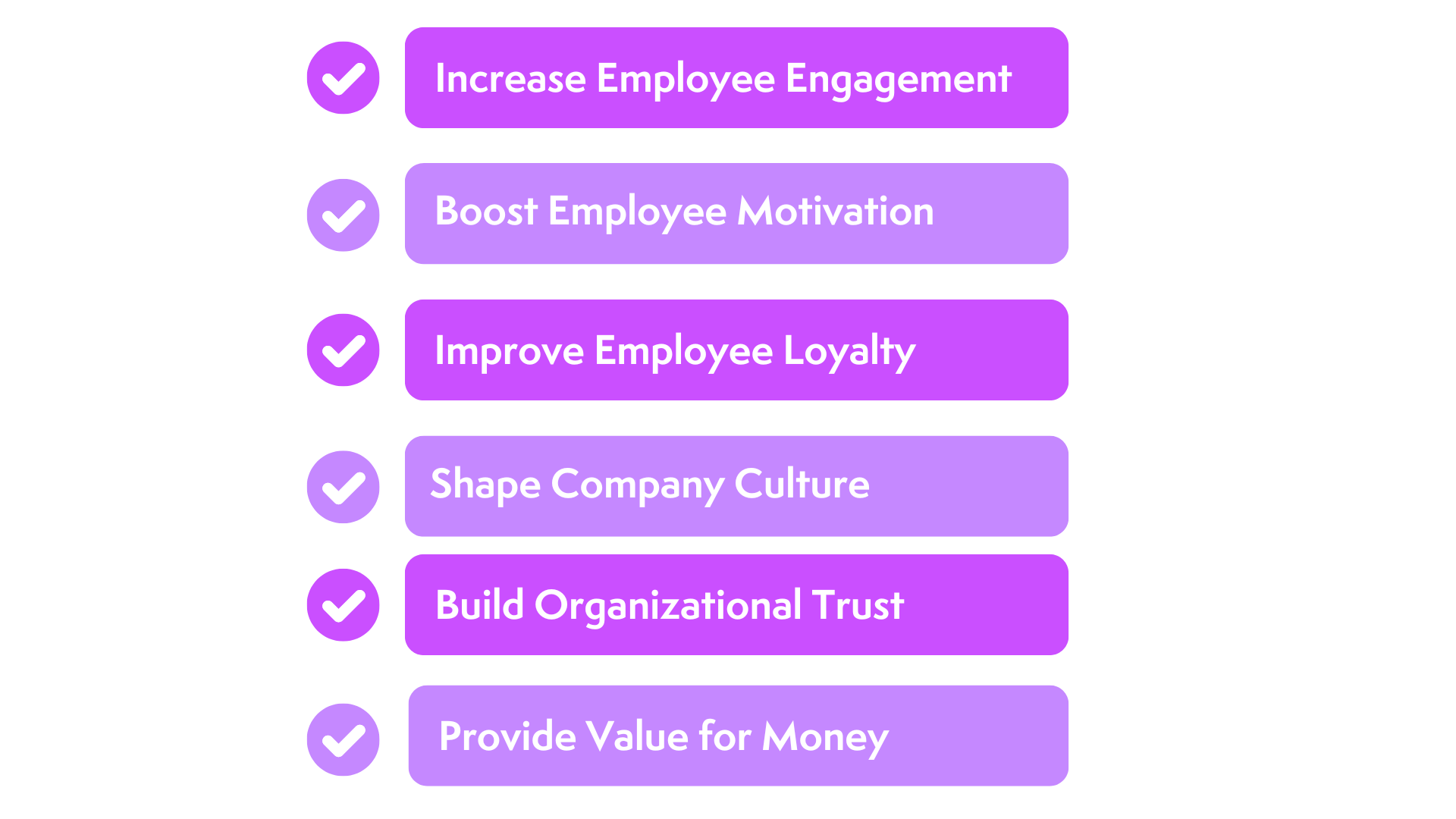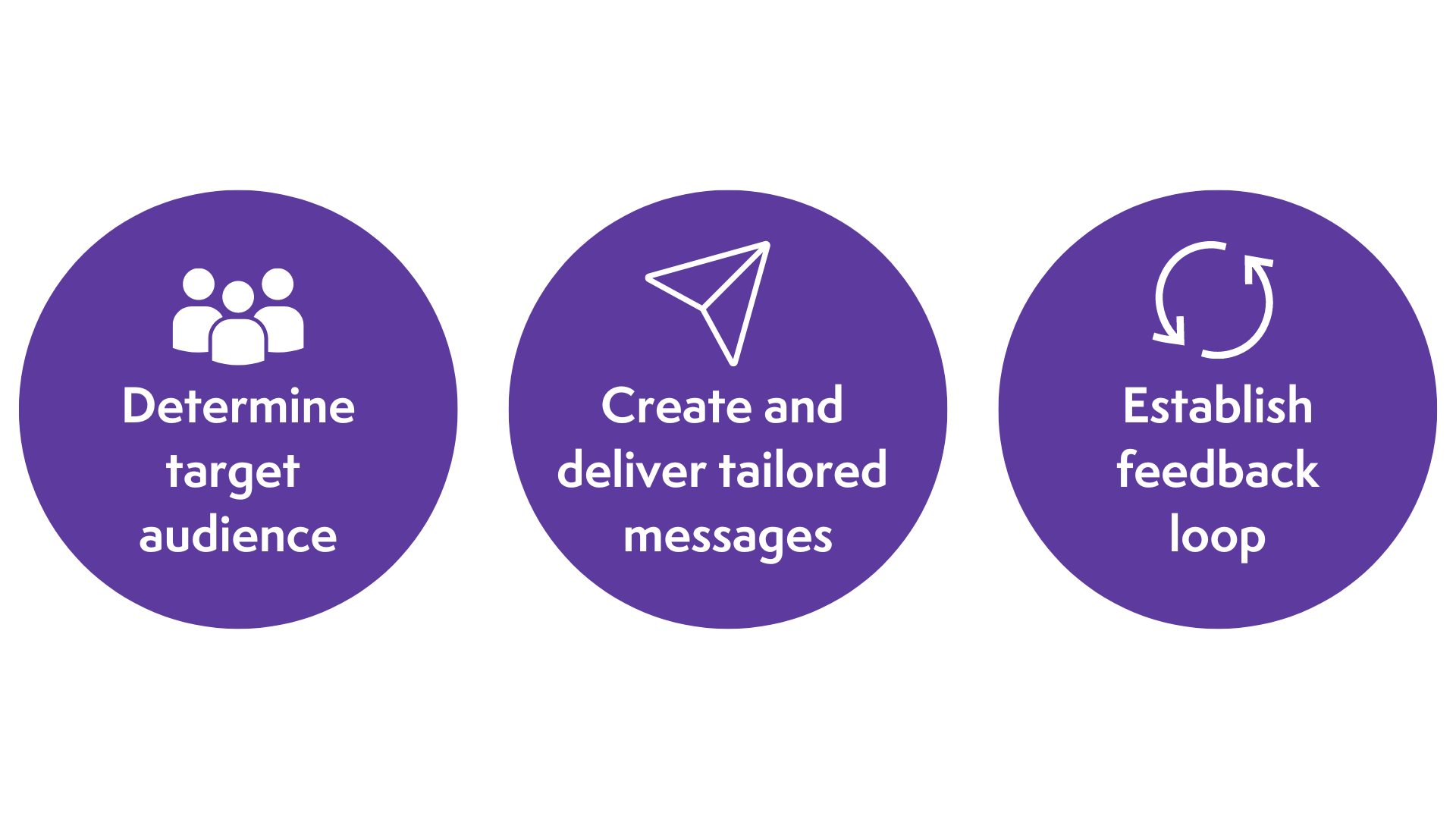Now more than ever, internal communications takes center stage in shaping the heartbeat of organizations. Employee engagement, experience, and retention significantly rely a lot on how effectively the company’s vision and goals are communicated. Especially in an era where information overflows and attention is scarce, clear and compelling communication can distinguish a thriving organization from a stagnant one.
In this article, we will be looking at what internal communications is today and what it can become to maintain a cohesive, motivated workforce that is responsive to both challenges and opportunities.
Internal communications in a nutshell
At its core, internal communications, IC for short, is about how leaders communicate with and to employees. As top-down as it might sound, internal communications actually reflects how an organization builds relationships with its workforce.
Since internal communications is a mix of human resources (HR), communication, and marketing, it doesn’t come as much of a surprise as to why internal comms tasks seem borderline HR. From maintaining open lines of communication and announcing new company policies to hosting town hall meetings and keeping the company intranet fresh, internal comms professionals are a bit of a jack of all trades.
Different roles that make up the internal communications department
The structure of the internal communications department can vary depending on the size and needs of the company. In large companies, the IC team typically includes all these roles and oversees the corporate communications strategy, which includes internal and external communications. In smaller ones, it might be a one man band or responsibilities shared amongst marketing and/or management teams.
Head of internal communications
A senior leader responsible for overseeing the IC department. They typically report directly to higher management or the executive team. The head of IC strategizes, develops, and implements internal communication strategies that align with the company’s strategic objectives and culture. Their tasks include:
- setting the overall direction for internal messaging
- ensuring consistent communication across all channels
- managing the IC team
- handling crisis communications
They often measure the impact of internal communications and make adjustments to strategies based on feedback and analytics.
Internal communications manager
Mid-level professionals who manage daily operations within the team under the direction of the head of department. Their day-to-day activities may include:
- planning and executing specific internal communications initiatives
- managing the production and dissemination of company news
- coordinating with different departments to ensure message accuracy and consistency
- handling the logistical aspects of internal events or campaigns
Internal communications specialist
IC specialists are typically more focused on the tactical aspects of internal communications than strategy. Their responsibilities include:
- supporting the creation and distribution of internal communications materials
- managing the company’s intranet or internal social media platforms
- ensuring that content is engaging and informative
They may also be involved in gathering constructive feedback from employees through surveys or focus groups to assess the effectiveness of internal communication plans.
Internal communications officer/executive
This role is similar to that of a specialist but can be more junior or less specialized. IC officers/executives typically assist in:
- implementing communication plans
- organizing internal events
- preparing presentations and informational materials
- maintaining communication schedules
Their work often includes writing and editing internal newsletters, emails, and announcements.
IC content creator/writer/editor
They are the creatives within the IC team. They write, edit, and produce content for various internal communication channels. This can include drafting emails, newsletter content, intranet articles, video scripts, and social media posts, to name a few. They ensure that all content is clear, engaging, and tailored to the internal audience while maintaining the voice and brand of the company.
Though their tasks seem to overlap with IC officers/executives, their primary focus is content development and editorial excellence rather than managing the broader tactical aspects of IC. For example, while IC creatives film, edit, and finalize, let’s say, A Day in the Life of a Shift Manager, IC officers/executives are responsible for coming up with a campaign to disseminate the video, making sure it reaches the intended audience with the appropriate message.
That said, you are less likely to find specialized creative IC roles in small companies, because these businesses usually need their staff to wear multiple hats due to resource constraints. As they often find themselves unable to justify the expense of a dedicated position solely for creating internal content, content writers or copywriters from the marketing department might also assist with internal messaging and other internal comms tasks.
What does internal comms actually do?
This study captures perfectly how the practice of internal communications has evolved over the years:
“Internal communication has emerged as a critical function for organizations and thereby meriting recognition as a specialty in itself.”
One of the biggest misconceptions about internal communications is that it is only about “sending out stuff” and telling people what to do. In fact, the scope of their contributions is much broader and significantly impacts several key areas, including:
- Increasing employee engagement
- Boosting employee motivation
- Improving employee loyalty
- Shaping company culture
- Building organizational trust and credibility
- Providing value for money
Internal comms is not about telling people what to do; it’s about listening to what employees need and finding ways to deliver messages with impact and ensure the right information reaches the right person at the right time. And these following tasks feed into making that a reality:
Disseminate information
From the most random updates like there’s a burst pipe in the men’s toilet on the fourth floor or a leftover cake in the break room begging to be eaten, to more significant announcements like a new mental health policy or updates from leadership, how else would you be in the know if not for internal comms?
While they may not literally shout “hear ye, hear ye,” internal communications serves as the corporate town crier, the bearer of news both mundane and monumental, the breaker of business silos.
The last thing, for example, your sales rep wants is to miss a critical deadline for submitting a PO for a customer because the reminder gets buried in less relevant emails about company-wide fitness challenges or cafeteria menu changes. This is why internal communications is needed.
Not only do they cut through the noise, but they make sure that important messages reach the right people. To ensure messages are not just sent, but also received and acted upon, internal comms often adopt these strategies:
-
- Create groups based on department, role level, and involvement in specific projects to tailor the communication more effectively.
- Tailor messages to suit how different groups prefer to receive their communications, whether through email, instant messaging, or internal social networks.
- Restrict mass emails and schedule communications to avoid overwhelming employees at peak times.
- Establish a feedback loop where employees can suggest improvements or express concerns about the current communication methods.
Deliver corporate narratives
The only time people cast their eye on your company’s vision statement is probably when they were prepping for a job interview with you (we know, ouch!). But what does this actually mean?
Could it be the case that your vision, mission, and values might not be engaging enough or effectively communicated to resonate regularly with employees and stakeholders? Is it integrated into the day-to-day culture of the company? Or is it not visible or relevant enough to influence daily work and decision-making?
When employees feel connected to their company’s vision and values, they are more likely to be engaged and committed to their work. In fact, 87% of Gen Z professionals would be prepared to quit their jobs to work elsewhere if the values of the new company were more closely aligned.
This is where internal communications steps in and helps bring these concepts off the walls and into daily conversations, creating narratives that connect the dots between individual roles and the larger company objectives.
Through regular storytelling, updates, and showcases of how teams and individuals are embodying these values, a sense of ownership and pride can be built across the company. Regular, engaging communication not only keeps these concepts top-of-mind but also demonstrates their relevance and helps everyone see how they contribute to the bigger picture.
Provide clarity
Do you remember being confused about whether you could work from home when COVID-19 first started and not knowing who to ask for a final say? Or whether your role will be put in limbo during a company merger? Or even when rumors about layoffs are circulating…?
In times of crisis or uncertainty, the role of internal communications becomes even more pivotal to ensure stability, maintain trust, and keep the workforce engaged and informed. They become a single source of truth for what matters most—and will effectively communicate during organizational change so the entire company remains united.
Internal comms work hand in hand with management to address situations directly, even if the full details are not yet available. This reduces misunderstandings and keeps everyone on the same page, which is critical when the organization’s future might be in question.
Create communication guidelines
Just like the rules of the road keep traffic flowing smoothly, communication guidelines in an organization serve to keep knowledge sharing effective and efficient.
The internal communications team ensures that messages across the company are clear and consistent. This prevents confusion and keeps everyone on the same page—quite literally! Whether it’s the CEO’s updates or news about the annual company trip, having a uniform style and format helps maintain a professional tone that is easily recognizable and understood by all.
These guidelines also help manage the narrative in a controlled and calm manner, ensuring that accurate and essential information is distributed quickly and efficiently to prevent rumors and misinformation. (See the above!)
When all internal messaging aligns with the company’s brand voice, it reinforces the company’s identity within the team, which, in turn, helps employees become better brand ambassadors in their interactions outside the company.
Facilitate effective communication
Say you have opinions or concerns that you want to raise with management, but you are not sure who to reach out to or simply just don’t know how to go about it. This is where internal communications team can come to the rescue.
Effective internal comms ensures that the relationship between leadership and employees is not just a transmission of orders, but a dynamic, two-way conversation that enhances collaboration and mutual understanding, which results in:
Leadership’s vision and decisions are clearly articulated and resonate with everyone in the organization.
Leaders stay connected to the workforce’s pulse and can adapt communication strategies that reflect the team’s insights and needs.
On the other hand, if talking to leadership feels like talking to a brick wall, or there’s a noticeable lack of communication across the company, it is a big red flag that your internal communications could use a major tune-up to create a more collaborative and responsive workplace.
Manage company’s communication channels
Imagine a big company with hundreds if not thousands of employees of all ages and across different departments and locations; sure, a mass email would land in everyone’s inbox, but that doesn’t mean it will get read by all of them.
Modern organizations are aware of how different generations have different preferences when it comes to how they consume information. While Baby Boomers and Gen X might prefer more traditional channels like phone calls and in-person meetings, Millennials and Gen Z favor instant messaging and social media.
So, you may ask, who is responsible for ensuring that every employee, regardless of their preferred mode of communication, feels informed and engaged? Internal communications team, that’s who! This is where IC officers/execs/creatives work their magic. This can look like:
-
-
-
- Customizing email content to target different groups within the organization based on their roles, locations, or preferences. This can be efficiently managed with the help of an AI email assistant, enhancing communication and engagement.
- Maintaining a regular posting schedule on the company intranet to keep content fresh and engaging.
- Hosting regular live-streamed town hall meetings that allow for real-time interaction.
- Utilizing push notifications on the mobile intranet to ensure timely delivery of important announcements.
- Incorporating feedback tools within channels to collect employee responses and suggestions.
- Providing training and resources to help employees effectively use communication tools.
-
-
Support change management and strategic planning
Change, whether big or small, can stir up anxiety and resistance among employees. As changes are implemented, internal comms keeps everyone updated on developments, timelines, and impacts. This continuous flow of information prevents the rumor mill from churning out misinformation and keeps everyone on the same page with the overall business strategy.
For strategic planning, internal comms translates the company’s goals and/or leadership’s vision into clear, actionable messages that resonate across all levels of the organization. This alignment is crucial because when people understand how their work directly contributes to the company’s objectives, they are more likely to pull in the same direction.
Through various communication channels, employees can voice concerns, ask questions, and suggest improvements. This two-way dialogue ensures that the change process is not just something done to employees but something done with them.
At the end of the day, effective internal communications makes sure that no one feels out of the loop, undervalued, or confused.
What lays in store for internal communications?
As we move forward, the landscape of internal communications is poised to undergo significant transformations, driven by technological advancements and shifting workplace dynamics.
-
-
-
- Integration of advanced technologies – Tools like AI and machine learning are becoming commonplace. These technologies can help tailor communications based on employee interactions and feedback, ensuring that messages are hyper relevant and engaging.
- Focus on employee experience – Internal communications will play a critical role in shaping and improving the employee experience, especially in terms of engagement, satisfaction, and retention. This involves not just sharing information but creating dialogues that include listening to employee feedback and acting on it.
- Greater emphasis on mobile accessibility – With remote and hybrid work models becoming more prevalent, mobile access to internal communications platforms is essential. Employees expect to access communications tools from anywhere, at any time, with the same ease as their consumer applications.
- Measurement and analytics – There will be a stronger focus on measuring the impact of internal communications strategies. Analytics will help comms teams understand what is or is not working, allowing for real-time adjustments and more strategic planning.
-
-
Highlighting these trends, in the Institute of Internal Communication podcast, Janet Hitchen, an internal communication leader with 20 years of experience working globally in Finance, Tech, FMCG, and Retail, discussed future opportunities for internal communicators.
Hitchen says, “There is this perception amongst people who don’t really understand what internal communications can be,” and highlights that internal communicators should aim to be more proactive rather than reactive.
Hitchen suggests that internal communicators step away from just being order takers and instead become strategic partners within their organizations. This shift involves engaging in meaningful dialogue about organizational needs and priorities, and not only transmitting messages.
There is a need for internal communicators to build confidence in their role and to see themselves as valuable contributors to organizational strategy. This includes developing business acumen and the ability to ask important questions that challenge the status quo and contribute to meaningful organizational change.
The future of internal communications will continue to move towards a more strategic, proactive, and integrated approach within organizations, where communicators are seen as key players in shaping organizational outcomes.
How Axero can help.
As internal communications team becomes a single source of truth, they deserve a tool, an ecosystem perhaps, that champions their cause. Enter Axero.
Axero internal communication software doesn’t just streamline communications; it transforms them into a dynamic dialogue, where information is not only shared but celebrated.
Picture a workplace where every update, from the latest project news to critical company-wide announcements, is instantly accessible to everyone. This is the environment Axero creates, reducing the reliance on overflowing email inboxes and ensuring that no crucial information slips through the cracks.
Axero goes beyond information dissemination. It enhances interactive engagement across all levels of the company. Employees can react to news, share insights, and even challenge ideas within a secure and managed space. This dynamic exchange keeps the workforce not only informed but also involved in the company’s pulse.
With Axero, your internal communications teams are more than just news deliverers. They become central figures in driving organizational change and fostering a connected, productive workplace culture.




















 info@axerosolutions.com
info@axerosolutions.com 1-855-AXERO-55
1-855-AXERO-55


